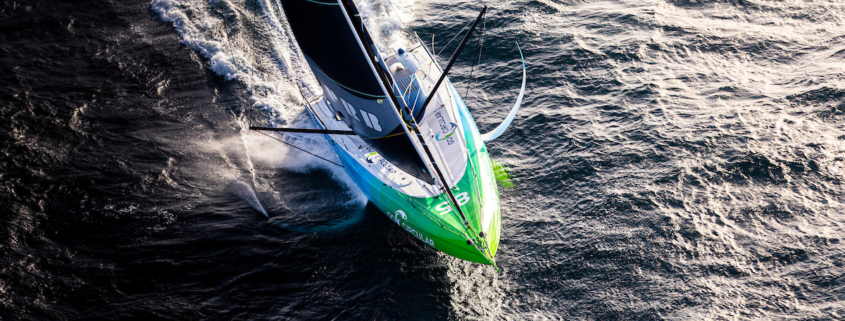Guillaume Verdier : 640 miles can be beaten…
It’s hard to believe that a sailing boat can cover a total distance in 24 hours that would equate to travelling from Paris to Alicante in southern Spain, the home of The Ocean Race, but that is what Holcim-PRB has now done.
Racing in Leg 5 of The Ocean Race from Newport to Aarhus, Kevin Escoffier’s new foiling IMOCA has set a new outright monohull world record for sailing boats of any kind, with a distance in 24 hours of 640.91 nautical miles.
This beats by 22 nautical miles the former outright monohull record held by the maxi Comanche. It also beats Holcim-PRB’s previous IMOCA record set during Leg 3 from Cape Town to Itajai of 595 miles, and is more than 100 miles further than the 539-mile record at the start of the race.
The new mark, which has yet to be officially verified by the World Speed Sailing Record Council, came as Escoffier’s team were sailing in almost perfect conditions for big mileages on Wednesday and Thursday – ahead of a weather front downwind on a relatively flat sea in 25-27 knots of southerly breeze in the north Atlantic.
The record came as they chased down leg leader 11th Hour Racing Team Mãlama which, like third-placed Team Malizia, also convincingly broke the 595-mile mark during this phase of racing, though Mãlama’s progress was hampered when she hit an obstacle in the water, thought to be a whale.
In terms of the equivalent distance on land coved by Holcim-PRB, 640 nautical miles equates to 736.5 statute miles. This is almost the exact distance – as the crow flies – from Paris to Alicante, a comparison which underlines the extraordinary range of the newest boats in the IMOCA Class.
But Holcim-PRB’s designer, the French Naval architect Guillaume Verdier (who also designed Comanche alongside VPLP), said he was not surprised by the latest leap in distance sailed and said he has no doubt that even 640 miles can be bettered.
“Oh for sure, yeah, yeah,” he said from his home in Brittany when asked if the new record can be beaten. “You mean in the state of where the boats are today? Oh yeah, for sure. The aerodynamics of these boats is pretty s*** to be honest. There is a lot that can be done to improve them and this will improve a lot, no doubt.”
Verdier added that possible future changes to the IMOCA rule, that might release even more power, could yet produce even more dramatic results on the racecourse. “Under the rule that they are selling today, they will be able to go further,” he said. “But if the rule evolved a little bit more, with more freedom – for example, allowing (foils) on the rudder that would allow full flying all the time. What we are seeing now is skimming, which is pretty good – it’s only 26 knots…”
Talking to Verdier – who designed not only Holcim-PRB, but Mãlama and Paul Meilhat’s Biotherm – it is clear that he regards the IMOCA design process as still a work in progress in almost all respects. He said he is disappointed about how uncomfortable the current boats are to sail and concerned about sailors spending their time in enclosed cockpits or “caves” as he put it.
And performance-wise, there are gains to be made, for example, in how the boats tackle big seas. “I am not fully satisfied, they slow down too much in the waves. I’m never fully satisfied,” said Verdier.



